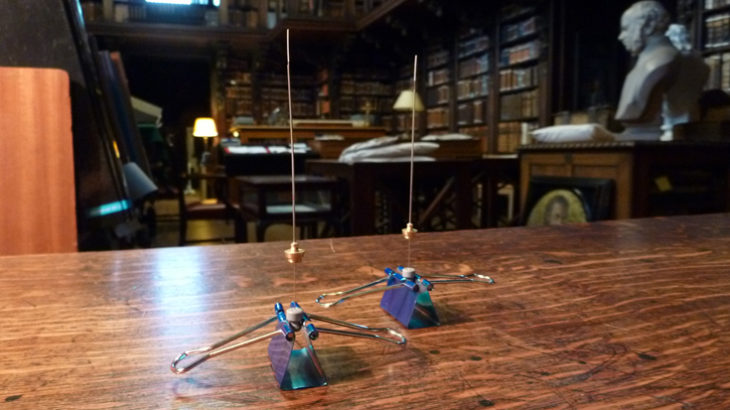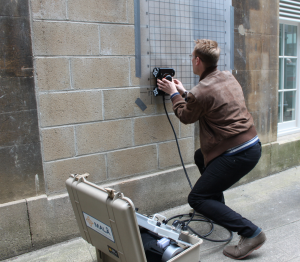Creating Future Masters in Heritage Science

The way we understand, preserve and present the past – and the cultural, educational, social and economic value we derive from heritage and from the arts more widely – is receiving a big boost from a ground-breaking Doctoral Training Centre launched in 2014.
Funded by the Engineering and Physical Sciences Research Council (EPSRC), the Science and Engineering in Arts, Heritage and Archaeology (SEAHA) Centre is a joint initiative by the UCL Institute for Sustainable Heritage, the University of Oxford and the University of Brighton. Aiming not just to aid conservation but also to build skills that illuminate our heritage and advance the arts, the Centre is already demonstrating how science and engineering can make a material difference to this sector, while directly benefiting industry too.
A Passport for the Future
‘Heritage science’ sounds like an oxymoron. But as the SEAHA Centre’s Mobile Heritage Lab criss-crosses the country, it underlines a key point: the contribution of science to heritage and the arts may occasionally be overlooked, but it can never be underestimated.
From cutting-edge techniques that locate, date and analyse ancient artefacts to digital technologies that deliver new possibilities for 3D and interactive displays in museums and galleries, science and engineering:
- equips experts to delve deeper into the past and safeguard it more effectively
- enables the public to connect with their heritage in new ways
- provides industry with opportunities to develop innovative solutions to meet future needs.
The Mobile Heritage Lab is just one small expression of how the Centre is helping to make it all happen. “Our mission is to train the next generation of heritage scientists,” says Professor May Cassar, the Centre’s Director. “Their impact will be felt across the country and the economy, providing insights and instruments that enhance knowledge, aid decision-making, help industry deliver new capabilities and encourage more people to connect more meaningfully with our heritage.”
“We aim to equip students with technical expertise and the ‘soft’, transferable skills needed to apply that expertise effectively within all kinds of organisations”
Professor Matija Strlic, SEAHA Centre Deputy Director.
On average, the Centre enrols 12 students a year onto its pioneering training programme, which is strengthened by the involvement of the three universities as well as heritage organisations and a wide range of companies.
“Harnessing the cross-disciplinary specialisms of different institutions and sectors translates directly into broader perspectives and wider opportunities for our students,” Professor Cassar explains. “For example, Oxford offers particular expertise in archaeological and environmental science, Brighton is at the forefront of digital heritage research, while UCL’s Heritage Science Lab is home to world-class researchers deploying equipment for characterising materials and analysing their degradation.”
“Our students’ impact will be felt across the country and the economy”
Professor May Cassar, SEAHA Centre Director
Studies in Innovation
The students’ disciplinary roots are in the arts, humanities, social sciences or STEM subjects (science, technology, engineering and maths). Whatever their background, every student:
- undertakes a 1-year Master of Research (MRes) course taught across the three universities
- moves on to a PhD project, working with a heritage organisation and an industrial partner, ranging from big multinationals to Small and Medium-sized Enterprises (SMEs).
The result is an extraordinary variety of research of practical value to the heritage sector and wider industry, as these examples of current PhD projects underline:
Plastics in the spotlight – Anna Pokorska, UCL
“I’m focusing on how plastic artefacts in heritage collections change physically and chemically due to the effects of light. Although the impact of light on the deterioration of museum objects has been studied for decades, identifying the best lighting strategies for plastic objects is difficult as they’re very varied and complex materials.
The Victoria & Albert Museum and technology company Philips are perfect partners for this project as they combine expertise in lighting, material degradation and plastics conservation. A key goal is to provide sound scientific evidence of the light sensitivity of plastics most commonly found in collections, and to use this as a basis for developing better guidelines for heritage institutions and for giving museum professionals more confidence in dealing with the display of plastic objects. Having access to equipment and facilities at all three universities will be invaluable.
Moisture monitoring in building materials – Scott Orr, Oxford University

“I’m assessing a whole range of technologies that can detect and measure moisture non-invasively. In conservation terms, the presence of water is a huge issue and my aim is to generate advice and insights of real value to those managing or surveying historic buildings.
My project partners – Historic Environment Scotland and Consarc Design Group, an architectural firm specialising in heritage projects – are providing fantastic opportunities to understand the issue at first hand, while the knowledge and facilities across SEAHA’s member institutions are a major potential asset. During my MRes, for instance, I benefited from training run by the Head of the Department of Applied Statistics at UCL and, looking ahead, the Mobile Heritage Lab could play a key role in my project. It’s already clear that the Centre is creating a unique environment where science, engineering and heritage can blend together in all kinds of imaginative ways”.
The smell of heritage – Cecilia Bembibre, UCL
“I’m exploring the connection between heritage and smell. Working with the National Trust and odour research consultants Odournet, this includes looking at how smell can be used to provide an authentic, multisensory environment that engages visitors at heritage attractions. For instance, I’ll be creating ‘smell maps’ and ‘smell walks’ at Knole House in Kent and, as part of identifying scientific methods for characterising, analysing, reproducing and archiving heritage smells, I’ll soon be spending time at Odournet’s lab in Barcelona.
I’m also hoping to explore the scope to collaborate with colleagues at Oxford and Brighton. Overall, the combination of highly interdisciplinary research, cross-institutional co-operation and access to real-life heritage scenarios and state-of-the-art technologies from industry provides the perfect framework for my project.”
Out into the World
So where will the Centre’s students eventually pursue careers? “They’ll find opportunities in the heritage, industry or policy sectors,” says Professor Matija Strlic, Deputy Director. “We aim to equip them not only with technical expertise but also with the ‘soft’, transferable skills needed to apply that expertise effectively within all kinds of organisations.”
The overall conclusion is clear: through its wide-ranging and forward-thinking training programme, the SEAHA Centre is set to ensure that leading-edge heritage science and engineering continues to be – in every way – a thing of the future.
Further information
Useful links
- SEAHA Centre
- UCL Heritage Science Lab
- Mobile Heritage Lab
- SEAHA Centre Twitter
- Smell of Heritage Twitter
- SEAHA Heritage sciences Facebook
- Heritage Science Research Network – Blog
Contacts
SEAHA Centre
UCL Institute for Sustainable Heritage
The Bartlett School of Environment, Energy and Resources
University College London
Central House
14 Upper Woburn Place
London WC1H 0NN

